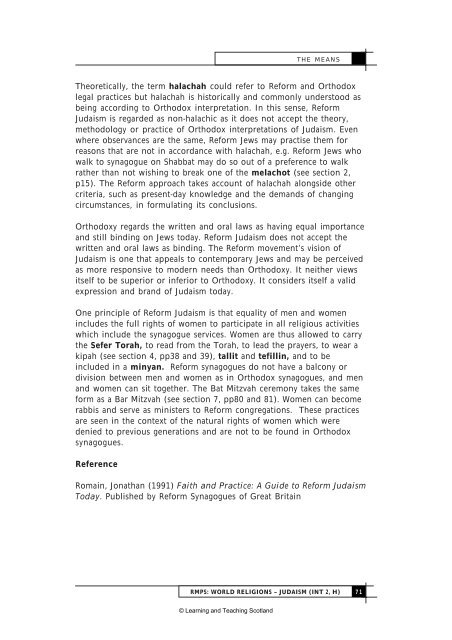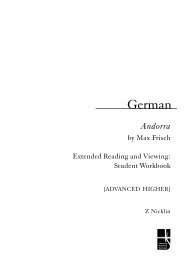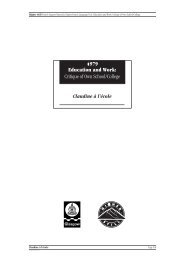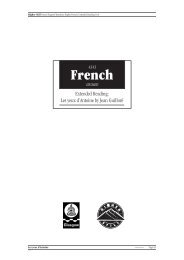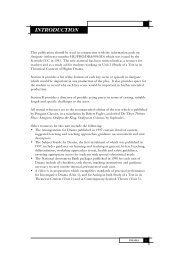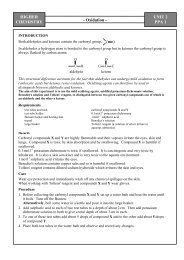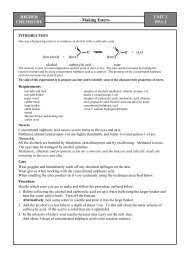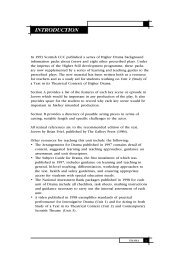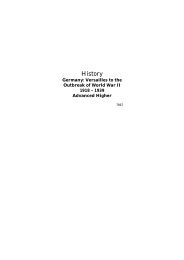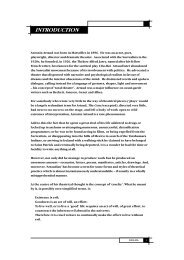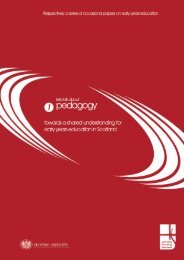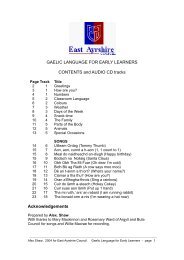RMPS - Int2/Higher - World Religions - Judaism - Education Scotland
RMPS - Int2/Higher - World Religions - Judaism - Education Scotland
RMPS - Int2/Higher - World Religions - Judaism - Education Scotland
You also want an ePaper? Increase the reach of your titles
YUMPU automatically turns print PDFs into web optimized ePapers that Google loves.
THE MEANS<br />
Theoretically, the term halachah could refer to Reform and Orthodox<br />
legal practices but halachah is historically and commonly understood as<br />
being according to Orthodox interpretation. In this sense, Reform<br />
<strong>Judaism</strong> is regarded as non-halachic as it does not accept the theory,<br />
methodology or practice of Orthodox interpretations of <strong>Judaism</strong>. Even<br />
where observances are the same, Reform Jews may practise them for<br />
reasons that are not in accordance with halachah, e.g. Reform Jews who<br />
walk to synagogue on Shabbat may do so out of a preference to walk<br />
rather than not wishing to break one of the melachot (see section 2,<br />
p15). The Reform approach takes account of halachah alongside other<br />
criteria, such as present-day knowledge and the demands of changing<br />
circumstances, in formulating its conclusions.<br />
Orthodoxy regards the written and oral laws as having equal importance<br />
and still binding on Jews today. Reform <strong>Judaism</strong> does not accept the<br />
written and oral laws as binding. The Reform movement’s vision of<br />
<strong>Judaism</strong> is one that appeals to contemporary Jews and may be perceived<br />
as more responsive to modern needs than Orthodoxy. It neither views<br />
itself to be superior or inferior to Orthodoxy. It considers itself a valid<br />
expression and brand of <strong>Judaism</strong> today.<br />
One principle of Reform <strong>Judaism</strong> is that equality of men and women<br />
includes the full rights of women to participate in all religious activities<br />
which include the synagogue services. Women are thus allowed to carry<br />
the Sefer Torah, to read from the Torah, to lead the prayers, to wear a<br />
kipah (see section 4, pp38 and 39), tallit and tefillin, and to be<br />
included in a minyan. Reform synagogues do not have a balcony or<br />
division between men and women as in Orthodox synagogues, and men<br />
and women can sit together. The Bat Mitzvah ceremony takes the same<br />
form as a Bar Mitzvah (see section 7, pp80 and 81). Women can become<br />
rabbis and serve as ministers to Reform congregations. These practices<br />
are seen in the context of the natural rights of women which were<br />
denied to previous generations and are not to be found in Orthodox<br />
synagogues.<br />
Reference<br />
Romain, Jonathan (1991) Faith and Practice: A Guide to Reform <strong>Judaism</strong><br />
Today. Published by Reform Synagogues of Great Britain<br />
<strong>RMPS</strong>: WORLD RELIGIONS – JUDAISM (INT 2, H) 71<br />
© Learning and Teaching <strong>Scotland</strong>


